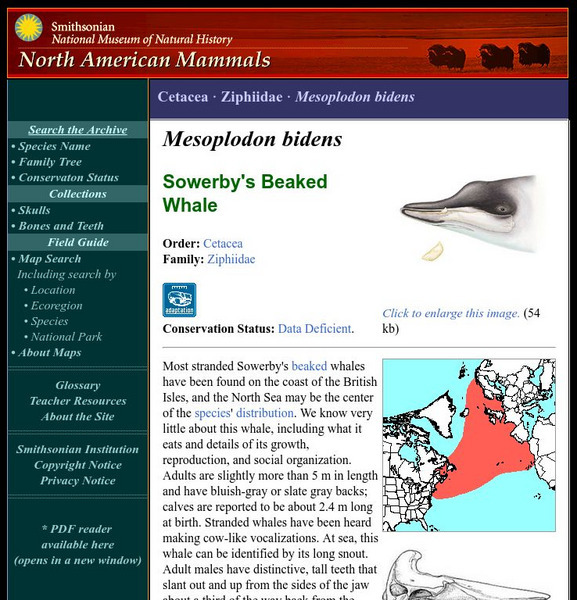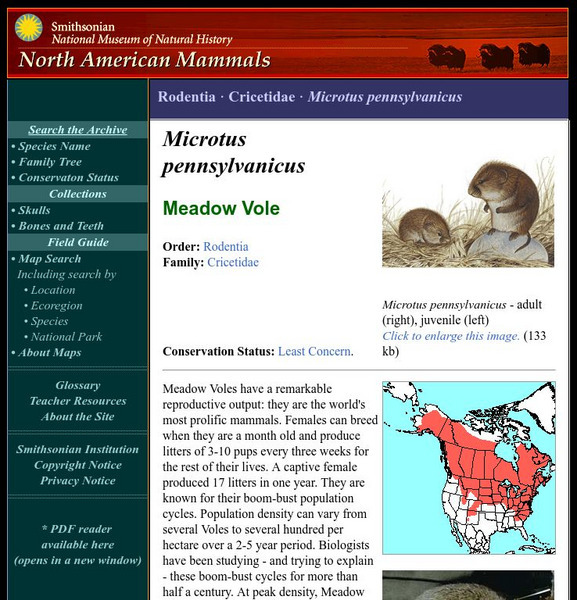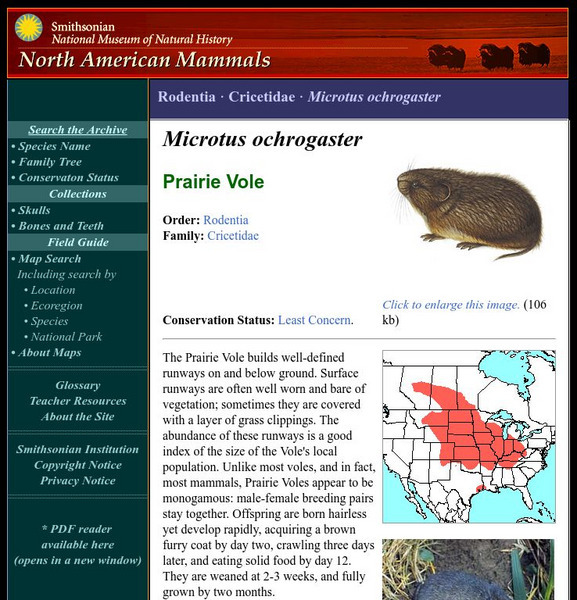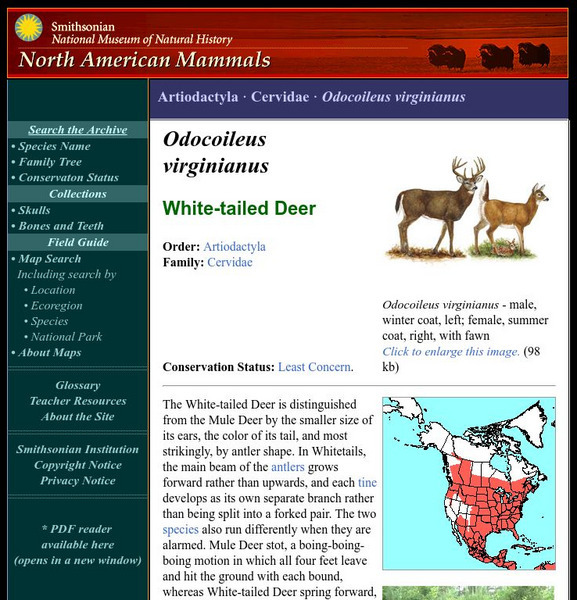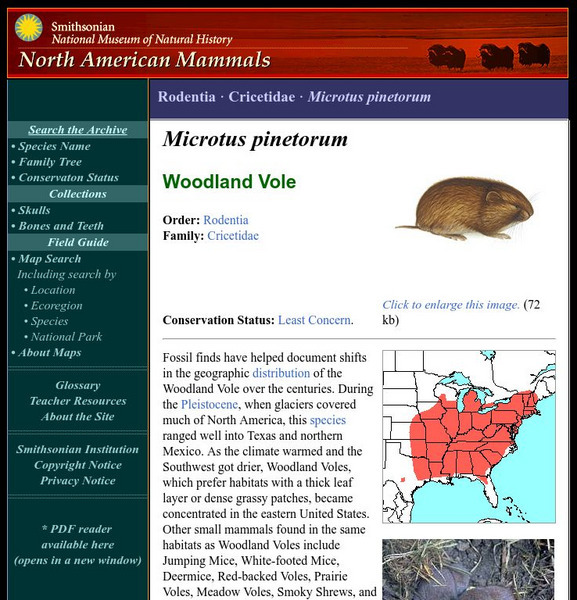Smithsonian Institution
National Museum of Natural History: American Mammals: Striped Skunk
The Striped Skunk is the most common skunk in North America, yet most of what we know about it comes from studies of captive individuals. Like all skunks, it has a superb defense system, the ability to spray a foul-smelling fluid from...
Smithsonian Institution
National Museum of Natural History: American Mammals: True's Beaked Whale
Found along the North American coastline from Nova Scotia to the Bahamas, True's beaked whale also inhabits temperate waters off the coast of Europe, and there are records of the species from near Australia and South Africa. Squid beaks...
Smithsonian Institution
National Museum of Natural History: American Mammals: Sowerby's Beaked Whale
Most stranded Sowerby's beaked whales have been found on the coast of the British Isles, and the North Sea may be the center of the species' distribution. We know very little about this whale, including what it eats and details of its...
Smithsonian Institution
National Museum of Natural History: American Mammals: Olympic Marmot
Olympic Marmots are highly social, living in groups made up of an adult male, one or more adult females, two-year-olds, yearlings, and young. Their diet consists of grasses and sedges, with flowering plants in season. Learn more about...
Smithsonian Institution
National Museum of Natural History: American Mammals: Woodland Jumping Mouse
Woodland Jumping Mice can make spectacular leaps of up to 4 m. They have large feet constructed from long foot and toe bones, and very long ankles, all of which help give them leverage when they push off. Learn more about the Napaeozapus...
Smithsonian Institution
National Museum of Natural History: American Mammals: White Throated Woodrat
Woodrats are also known as Packrats, because they cache various manmade objects in their dens. This habit of collecting foreign objects is useful to scientists, who can place numbered sticks throughout an area and later open a den,...
Smithsonian Institution
National Museum of Natural History: American Mammals: Mexican Woodrat
Mexican Woodrats inhabits rocky outcrops, cliffs, and slopes, primarily in montane regions from northern Colorado to Honduras. They eat a wide variety of leaves, seeds, and berries, and sometimes store large amounts of food. Learn more...
Smithsonian Institution
National Museum of Natural History: American Mammals: White Eared Pocket Mouse
One subspecies of the White-eared Pocket Mouse may be extinct, and the other is extremely rare, consisting of isolated, relict populations near the western Mojave Desert in California. White-eared Pocket Mice are nocturnal and probably...
Smithsonian Institution
National Museum of Natural History: American Mammals: Plains Pocket Mouse
The color of the Plains Pocket Mouse varies with soil color. The black volcanic sands near Flagstaff, Arizona harbor mice with nearly black fur, and mice with nearly white fur match the white gypsum dunes of New Mexico. Learn more about...
Smithsonian Institution
National Museum of Natural History: American Mammals: Olive Backed Pocket Mouse
The striking olive dorsum of the Olive-backed Pocket Mouse is set off by a yellowish stripe on the side and a white underside. This is the only species of pocket mouse east of the Rocky Mountains whose range extends well into Canada....
Smithsonian Institution
National Museum of Natural History: American Mammals: Northern Rock Deermouse
Northern Rock Deermice live in rocky outcrops and among boulders in pinyon-juniper-oak woodlands in the foothills of mountains from Colorado and New Mexico south to Texas and northern Mexico. Populations of the Mice are separated from...
Smithsonian Institution
National Museum of Natural History: American Mammals: Osgood's Mouse
Osgood's Mouse is a very close relative of the Pinyon Mouse but is larger, and its tail is longer than the head and body. Osgood's Mouse lives in the mountains of southern New Mexico and throughout mountainous central Mexico. Learn more...
Smithsonian Institution
National Museum of Natural History: American Mammals: Marsh Rice Rat
Marsh rice rats are among the most common mammals inhabiting tidal marshes of the Gulf and Atlantic coasts. Being good swimmers, diving to 10 m and crossing 300 m stretches of water, and able climbers, these rice rats are suitably...
Smithsonian Institution
National Museum of Natural History: American Mammals: Pygmy Rabbit
Pygmy Rabbits dig extensive burrow systems, which are also used by other animals. Loss of habitat is a direct threat to this species, which depends on big sagebrush, particularly mature stands of it. Learn more about the Brachylagus...
Smithsonian Institution
National Museum of Natural History: American Mammals: Townsend's Mole
The largest moles in North America, weighing in at 100 - 171 grams, Townsend's Moles live only in the lowlands on the western side of the Cascade Mountains, from northwestern California to extreme southwestern British Columbia. One...
Smithsonian Institution
National Museum of Natural History: American Mammals: Nelson's Antelope Squirrel
Open, rolling land and gentle slopes with shrubs are the habitat of Nelson's Antelope Squirrel, which lives only in a small region of California in and near the San Joaquin Valley. The squirrels live in relatively small colonies of six...
Smithsonian Institution
National Museum of Natural History: American Mammals: Yellow Nosed Cotton Rat
Voles and cotton rats usually live in different geographic regions, but both groups of small rodents eat grass and make runways. Yellow-nosed Cotton Rats are especially vole-like because they are small and live in grassy patches of...
Smithsonian Institution
National Museum of Natural History: American Mammals: Stejneger's Beaked Whale
Thirty-one of the 48 sightings of Stejneger's beaked whale have come from Alaskan waters. It is suspected this species favors deep waters, including the Aleutian Trench and the Aleutian Basin, which is some 3,500 m deep, rather than the...
Smithsonian Institution
National Museum of Natural History: American Mammals: Meadow Vole
Meadow Voles have a remarkable reproductive output: they are the world's most prolific mammals. Females can breed when they are a month old and produce litters of 3-10 pups every three weeks for the rest of their lives. Learn more about...
Smithsonian Institution
National Museum of Natural History: American Mammals: Tundra Vole
Tundra Voles have the northernmost distribution of any North American species of Microtus. They are widespread in northern latitudes in Eurasia, too, where they are known as Root Voles, and probably migrated to North America across the...
Smithsonian Institution
National Museum of Natural History: American Mammals: Long Tailed Vole
Long-tailed Voles need cool, moist habitats, so they are found mostly near the peaks of mountain ranges. Fruits and seeds make up the bulk of their diet, but they also eat fungi, bark, and leaves if necessary. Learn more about the...
Smithsonian Institution
National Museum of Natural History: American Mammals: Prairie Vole
The Prairie Vole builds well-defined runways on and below ground. Surface runways are often well worn and bare of vegetation; sometimes they are covered with a layer of grass clippings. Learn more about the Microtus ochrogaster, more...
Smithsonian Institution
National Museum of Natural History: American Mammals: White Tailed Deer
The White-tailed Deer is distinguished from the Mule Deer by the smaller size of its ears, the color of its tail, and most strikingly, by antler shape. In Whitetails, the main beam of the antlers grows forward rather than upwards, and...
Smithsonian Institution
National Museum of Natural History: American Mammals: Woodland Vole
Fossil finds have helped document shifts in the geographic distribution of the Woodland Vole over the centuries. During the Pleistocene, when glaciers covered much of North America, this species ranged well into Texas and northern...


